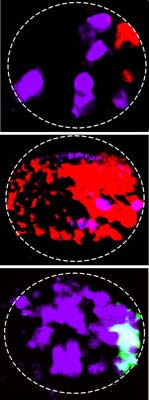UCSD Biologists Discover That Nerve Activity, Not Just Genetics Controls Kinds Of Neurotransmitters Produced

Photo shows different neurotransmitters in red and purple in normal frog embryos and embryos with decreased and increased nerve activity (from top to bottom) Photo credit: Laura N. Borodinsky, UCSD
Neurobiologists at the University of California, San Diego have discovered that altering electrical activity in nerve cells can change the chemical messengers the cells generate to communicate with other cells, a finding that may one day lead to new treatments for mood and learning disorders.
In a study published in the June 3rd issue of the journal Nature, a team led by UCSD professor of biology Nicholas Spitzer shows that manipulating the electrical activity of developing nerve cells can alter the type of neurotransmitter—chemicals that carry information between nerve cells at junctions called “synapses”—they produce. A review paper discussing these results will appear in July in Trends in Neurosciences. The results are important because scientists had long believed that the different kinds of neurotransmitters used by different nerve cells were genetically programmed into the cell.
“If you were to ask neuroscientists what learning is in cellular and molecular terms, none would have said it is the changing identity of neurotransmitters,” says Spitzer. “That would have been heresy because everyone thought neurotransmitter identity was genetically programmed. Our results show that by altering neural activity, you can change the identity of the neurotransmitter a particular cell produces, raising the possibility that disorders caused by problems with neurotransmitters could be treated by modifying neural activity.”
In the study, the UCSD group increased or decreased the electrical activity in frog embryonic spinal nerve cells by altering the current through nerve cell membranes with drugs or by genetic manipulation. They found that increases in activity increased the levels of neurotransmitters that inhibit the activity of nerve cells across the synapse and decreased the levels of neurotransmitters that stimulate nerve cells. Decreasing electrical activity had the opposite effect.
These results led the researchers to propose that while genes control the formation of structures that produce electrical activity in nerve cells, the activity itself can determine what neurotransmitters are produced. According to Spitzer, this could provide flexibility for the growth and operation of the nervous system.
“Biology is a little sloppy,” explains Spitzer. “A nerve cell may need to grow to the other side of the developing brain and form a synapse there. Genes can do a lot to specify where to grow, but precision is not absolute. So instead of genes specifying everything, activity can play a role by fine tuning what neurotransmitters are expressed when the nerve cell finds its target.”
It is not yet clear how activity affects neurotransmitters in the adult nervous system, but Spitzer thinks there is a good chance activity will play a similar role there as well.
“Often the processes we see in the embryonic nervous system we also see in the adult, albeit in a much more muted way,” he says.
If so, these findings could open new avenues for treating mental illnesses like depression, phobias, schizophrenia and bipolar disorder, which together affect 20 percent of the U.S. population each year, with estimated cost of treatment and lost productivity totaling approximately $150 billion, according to the U.S. Surgeon General.
“Focal stimulation of the brain to elicit changes in neurotransmitter production could have advantages over current drug treatments and electroconvulsive therapy—stimulation of the whole brain with electric current,” notes Spitzer. “These treatments work for many patients, but both treat the entire brain in an imprecise way and have side effects.”
The first author on the paper, Laura Borodinsky, a postdoctoral fellow in Spitzer’s laboratory, is now studying how the cells across the synapse receiving the neurotransmitter change in response to being exposed to a different neurotransmitter. Using changes in activity to treat neural disorders would depend on the ability of these cells to respond appropriately to the new neurotransmitter. Further research is also needed, the UCSD scientists say, to determine if the 50 to 100 other known neurotransmitters are also regulated by activity.
Other UCSD contributors to the publication were Cory Root, Julia Cronin, Sharon Sann and Xiaonan Gu. The study was supported by the National Institutes of Health, National Science Foundation and Merck.
Media Contact: Sherry Seethaler (858) 534-4656
Comment: Nicholas Spitzer (858) 534-2456
Media Contact
More Information:
http://ucsdnews.ucsd.edu/newsrel/science/sactivity.aspAll latest news from the category: Life Sciences and Chemistry
Articles and reports from the Life Sciences and chemistry area deal with applied and basic research into modern biology, chemistry and human medicine.
Valuable information can be found on a range of life sciences fields including bacteriology, biochemistry, bionics, bioinformatics, biophysics, biotechnology, genetics, geobotany, human biology, marine biology, microbiology, molecular biology, cellular biology, zoology, bioinorganic chemistry, microchemistry and environmental chemistry.
Newest articles

An Endless Loop: How Some Bacteria Evolve Along With the Seasons
The longest natural metagenome time series ever collected, with microbes, reveals a startling evolutionary pattern on repeat. A Microbial “Groundhog Year” in Lake Mendota Like Bill Murray in the movie…

Witness Groundbreaking Research on Achilles Tendon Recovery
Achilles tendon injuries are common but challenging to monitor during recovery due to the limitations of current imaging techniques. Researchers, led by Associate Professor Zeng Nan from the International Graduate…

Why Prevention Is Better Than Cure—A Novel Approach to Infectious Disease Outbreaks
Researchers have come up with a new way to identify more infectious variants of viruses or bacteria that start spreading in humans – including those causing flu, COVID, whooping cough…



